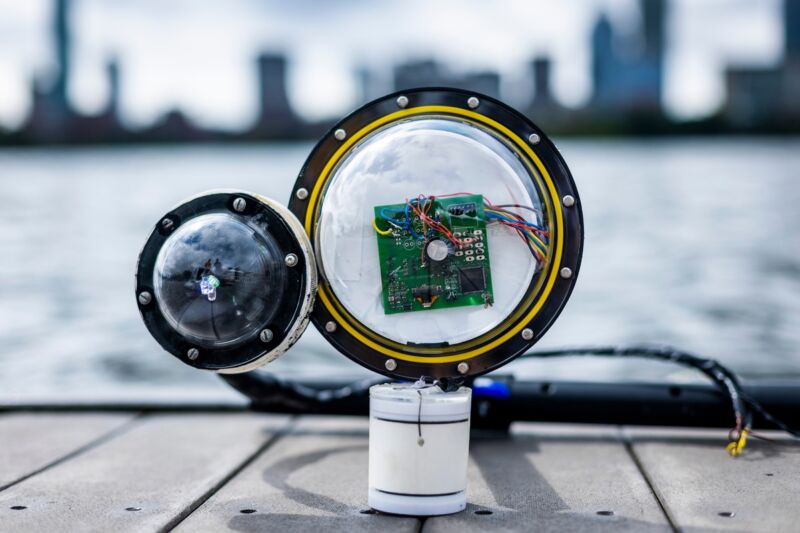Adam Glanzman
MIT engineers have developed a battery-less wireless underwater camera capable of self-storage with very low power consumption. new paper Published in Nature Communications. The system can remotely capture color images of submerged objects – even in the dark – and transmit data wirelessly for real-time monitoring of the underwater environment to aid in the discovery of new rare species, ocean currents, pollution, or commercial and military operations. .
We already have a variety of ways to take underwater pictures, but according to the authors, “much marine and marine life has yet to be observed.” This is partly because most current systems require them to be connected to ships, underwater drones or power plants for both power and communication. Methods that do not use tethering must involve battery power, which limits lifespan. While it is in principle possible to harvest energy from ocean waves, underwater currents, or even sunlight, adding the necessary equipment to do so would require much larger and more expensive underwater cameras.
So the MIT team set out to develop a battery-free wireless imaging solution. The design goal was to reduce the required hardware as much as possible. For example, because they wanted to keep power consumption to a minimum, the MIT team used inexpensive, off-the-shelf image sensors. The downside is that these sensors only produce grayscale images. The team also had to develop a low-power flash because most underwater environments don’t have much natural light.
SS Afzal et al., 2022
It turns out that solving both challenges involves red, green, and blue LEDs. The camera uses a red LED to illuminate the location, captures this image with its sensor, and then repeats the process with green and blue LEDs. The image may appear black and white, the authors say, but all three colors of light from the LEDs are reflected on the white part of each image. Thus, a full-color image can be reconstructed during post-processing.
“When we were kids in art class, we were taught that we could make any color with the three primary colors.” Co-author Fadel Adib says:. “It follows the same rules for the color images we see on our computers. We only need these three channels – red, green and blue – to create a color image.”
Instead of a battery, the sensor relies on piezo-acoustic backscatter for very low-power communication after encoding the image data as bits. This method does not have to generate its own audio signal (like sonar, for example), but instead relies on modulating underwater sound reflections to transmit data bit by bit. This information enables a remote receiver to retrieve the modulated patterns and is then used to reconstruct the binary data image. The authors estimate that their underwater camera is about 100,000 times more energy efficient than its counterparts and can last for weeks.
Of course, the team built a proof-of-concept prototype and ran some tests to prove their method worked. For example, they found pollution (in the form of plastic bottles) in Keyser Pond in southeastern New Hampshire and African starfish (Proterstar Linkley) “in a controlled environment with external lighting”. The resolution of the final image was good enough to capture the various tubercles along the five arms of the starfish.

SS Serra et al., 2022
Using wireless underwater cameras, the team was also able to observe the growth of an aquatic plant (Aponogeton ulvaceus) over several days, identification and localization of visual tags commonly used for underwater tracking and automated processing. Up to a distance of about 3.5 meters, the camera achieved high detection rate and high localization accuracy; The authors suggest that longer detection ranges can be achieved with higher resolution sensors. Distance is also a factor in the camera’s ability to gather energy and communicate, according to tests conducted in the Charles River in eastern Massachusetts. As expected, these two important capabilities decrease with distance, although the camera successfully transmits data up to 40 meters (131 feet) from the receiver.
In summary, the authors write, “The unconstrained, low-cost, and fully integrated nature of our approach makes it a desirable approach for large ocean propagation.” Scaling up their approach requires more advanced and efficient transducers as well as higher power. Acoustic transmission under water. It is also possible to use existing mesh networks of surface sea buoys or networks of underwater robots such as Argo buoys to remotely operate energy-harvesting cameras.
“One of the most exciting applications of this camera for me personally is climate monitoring,” Adib said. “We build climate models, but we don’t have data on more than 95 percent of the ocean. This technology can help us build more accurate climate models and better understand how climate change is affecting the underwater world.”
DOI: Nature Communications, 2022. 10.1038/s41467-022-33223-x (About DOI)













![10 Essential Image Optimization Tips to Improve Your Blog Posts [Infographic]](https://www.socialmediatoday.com/imgproxy/vp8xra72H25kWT1bPbdDOUO4vfbCwd4Uy8joTIY9SZI/g:ce/rs:fill:770:364:0/bG9jYWw6Ly8vZGl2ZWltYWdlL2ltYWdlX29wdGltaXphdGlvbjEucG5n.png)